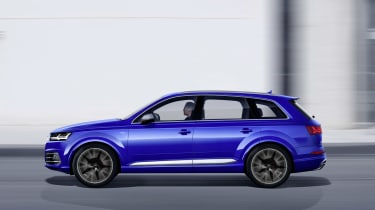Audi SQ7 TDI revealed – 429bhp SUV takes on Porsche and Range Rover
Technological features include electric turbocharging and active anti-roll bars
The market will soon have a new super-SUV, with the launch of Audi’s hottest SUV yet – the SQ7 TDI.
Not only is it the fastest Q7 yet – courtesy of a 429bhp diesel powerplant – but it’s technologically advanced too, with a world-first electric-powered compressor, variable valve lift and active body roll stabilisation.
The end result is an SUV that mixes high performance with monstrous torque and impressive economy – and should drive better than any Q7 before it.
Behind the bluff nose is a completely redeveloped version of Audi’s V8 diesel engine. Displacing 3956cc, it features two sequential exhaust gas turbochargers in a ‘hot vee’ arrangement (mounted inside the vee of the V8), ensuring low-down grunt and top-end urge, as well as a world-first electric powered compressor.
This is used to support the two traditional turbos. Mounted downstream of the intercooler, it can spool up at any time and with effectively zero lag (a 250ms response time), covering any flat spots in the delivery of the other turbos – for example, starting off from rest.
It’s augmented by Audi valvelift system (AVS), making its first appearance in an Audi diesel. Each inlet and exhaust camshaft has two cam countours for each valve – one profile works with the electric compressor and first turbocharger at low engine speeds, switching to the other to bring the second turbo on-stream as load and engine speeds increase.
The result of the underbonnet trickery is 429bhp and 663.8lb ft of torque between 1000-3250rpm. Combined with all-wheel drive and an eight-speed tiptronic automatic gearbox, it’ll hit 62mph in 4.8sec and reach a limited 155mph – figures that put it within a whisker of the Porsche Cayenne Turbo and Range Rover Sport SVR.
While each of those come with economy figures in the low-to-mid 20s, the SQ7 is also relatively frugal: European combined economy is quoted at 38.2mpg.
Aiding handling is an electromechanical active body roll stabilisation system. The aim is to ensure ride comfort on rougher surfaces – where the anti-roll bar is decoupled to allow greater movement – while the two sides are interconnected and twisted against each other in cornering, to reduce body roll. All-wheel steering is also employed to improve both high-speed stability and low-speed manouevres.
Exterior styling is as you’d expect from an Audi S model: subtle changes to the bumpers, larger air inlets, prominent tailpipes and new alloy wheels. LED headlights are standard with Matrix LEDs optional, and inside there’s a choice of five or seven seat layouts. Virtual Cockpit is also optional.
Order books open in the Spring with the first UK cars set to arrive towards the end of 2016. The car’s 89,900 euro base price currently equates to around £70,000, which in turn is around £17,000 more than the existing Q7 range-topper.








